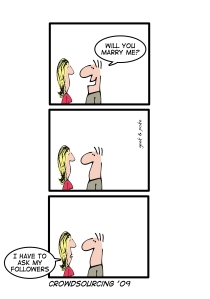Posts Tagged ‘innovation’
Thought o’ the day
Posted on: January 6, 2012
So much about innovation is changing. Globalization, increased need for speed to market, increased costs, mobile workforce, and maybe most importantly the proliferation of the Internet and online collaborative tools. I think O’Reilly’s quote sums it up nicely.
“The central principle behind the success of the giants born in the Web 1.0 era who have survived to lead the Web 2.0 era appears to be this, that they have embraced the power of the web to harness collective intelligence.”
O’Reilly, 2005
Crowdsourcing #1 for 2012
Posted on: August 2, 2011
 As a researcher studying crowdsourcing I was excited to see that Haydn Shaughnessy of Forbes magazine predicts that crowdsourcing will be top of mind for companies in 2012. While I agree that crowdsourcing examples are on the rise, I’m not sure I agree that crowdsourcing is a “fail safe” option that is a “mature” as Haydn suggests.
As a researcher studying crowdsourcing I was excited to see that Haydn Shaughnessy of Forbes magazine predicts that crowdsourcing will be top of mind for companies in 2012. While I agree that crowdsourcing examples are on the rise, I’m not sure I agree that crowdsourcing is a “fail safe” option that is a “mature” as Haydn suggests.
We’ve only begun to examine the economic impacts of crowdsourcing initiatives on the corporate bottom line. Some studies are finding that turning to the crowd has reduced cost and time for product innovation and problem solving, improved quality, and increased market acceptance of new products. In fact, TopCoder a site that runs contests for developing complex software applciations reports that projects typically requiring over a year of development have been completed in slightly over five months. Additionally, TopCoder programs average .98 bugs per thousand lines of code, significantly better than the industry standard of six per thousand. These initial findings are promising, but more research is needed to determine the true benefits to corporations.
While potentially more economical than traditional innovation methods, crowdsourcing does not come without costs. It is not a “build it and they will come” solution. Success requires defined business goals, an understanding of crowd dynamics as well as collaborative technologies. Additionally, those who are getting the crowd to participate are often finding it difficult to sort through and evaluate all the information and ideas that are generated.
One of the biggest hurdles is organizational culture. I saw a similar issue when working with companies to leverage social media for marketing initiatives. Success at leveraging the crowd requires an organizational culture that embraces open methods from the top down and is willing to give up some control. Exposing yourself and your company to the crowd can be scary and isn’t without risk. Lawyers raise concerns about leakage of trade secrets and issues related to intellectual property. Employees may feel they are becoming obsolete and fear for their jobs. And, executives may pull the plug when they encounter negative feedback or comments from customers.
Every day there are new and different uses of the crowd for innovation. While companies like P&G and intermediaries like InnoCentive seem to have it down, most are only beginning to experiment with leveraging the crowd for innovation. I do agree that crowdsourcing may be an excellent opportunity for companies to supplement or even replace their current innovation initiatives – saving money and time in the process. But currently we have only scant evidence of the how best companies can extra value from the crowd.
(Cartoon (c) Geek and Poke, 2009)
Title: Where Good Ideas Come From: The Natural History of Innovation
Pub Date: 2010
 Excellent look at ideation and the development of ideas over time. Both theoretical and practical.
Excellent look at ideation and the development of ideas over time. Both theoretical and practical.
Key to Johnson’s discussion is the concept of the “adjacent possible.” Simply put, like ideas tend to cluster together. When you bring different clusters together you benefit from ideas in adjacent groups. Ideas bleed into adjacent groups, or spillover, and generate new ideas.
Johnson also debunks the notion of the “eureka moment.” Instead, Johnson shows that new innovative ideas are often born of long held hunches. Those hunches that ruminate in the back of your mind for weeks, months, and even years.
According to Johnson, “the secret to organizational inspiration is to build information networks that allow hunches to persist and disperse and recombine.” By creating high density liquid networks, organizations make is easier for innovation to happen.
But don’t take my word for it, hear Johnson describe where good ideas come from in his own words.

